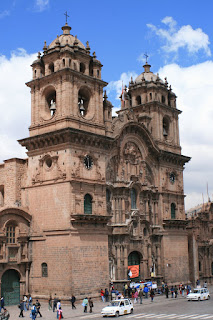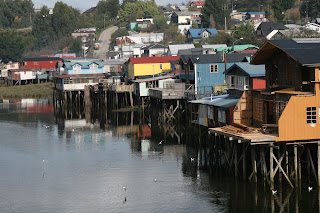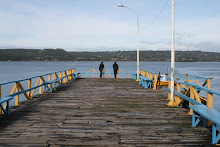Early Friday morning Maria and I met at the bus terminal to catch a bus over to Santiago. Maria, formally known as Molly, is a friend from Middlebury who is also studying at UPLA in the same program. We had planned to get away for the weekend on a simple camping and backpacking trip to Cajon de Maipo. My friend Sergio recommended to me this area as it is only about an hour and a half outside of Santiago with plenty of places to camp and a beautiful National Park, El Parque El Morado. It all seemed very simple. All we needed to do was get a bus to Santiago, buy a stove, get a bus to San Jose de Maipo, and finally take one more bus to Baños Morales. We planned on getting to the park in the early afternoon, hiking for about two hours to a glacial lagoon and setting up camp.
Needless to say, we are naive gringos in a land where flexible plans are a necessity.
When we arrived in Santiago we rode the subway and then a bus to a mall on the other side of town where Sergio recommended that we buy a stove. In addition to buying the stove and a thermos I was tempted by a glorious foodcourt full of all my favorites: Burger King, Taco Bell, Subway, and yes, the glorious McDonald's. Immediately I got in line with my giant purple backpack and ordered a Cuarto de Libre con Queso (Quarter Pounder with Cheese Whatup!). After feasting, we returned to the Metro and when we got to our intended stop we where informed that the buses for Cajon de Maipo were now at a different station on the other side of town. Finally we arrived at the station that we were told was correct.
We walked around, confused and all geared out in our backpacking clothes for a while until we finally asked a guard where the buses left for Cajon de Maipo. He told us they were in front of the building but when we went to find it there were about thirty buses honking their horns in a two lane highway. So, Maria asked another guard where we could find our bus and after consulting his amigos on his radio he replied that we needed to go to the back of the building . So we returned to the other guard where he insisted very sternly that he had been working at the station for many years and that he was sure that all the buses for Cajon de Maipo where out front. Assuredly (kind of), Maria and I entered into the maze of buses and consulted some chicos which bus we needed to take. They were very helpful and pointed out one bus that said "Buin-Maipo." Ah, Maipo, this must be our bus. After missing one or two of these buses due to our confusion we finally hopped on the bus and I asked the driver, "This goes to Cajon de Maipo, right?" He nodded his head and asked for 700 pesos which we were glad to give for our reassurance that all we had to do was relax as our destination approached.
About an hour later I looked out the window and saw signs for Buin. I consulted the small map that Maria was smart enough to tear out of her Lonely Planet guide and saw that Buin was not at all in the direction of Cajon de Maipo. Ah no matter, I thought, the bus must go there next. The driver did after all say that we were on the right bus.
Slowly all the people on the bus began to trickle off and eventually it was only Maria, me, and another hombre. I asked the man, "Are we close to San Jose de Maipo? We are trying to get to Baños Morales, can we take a collectivo from here?" He assured me that we only needed to walk a few blocks more and we would be there. Great, I thought. However, as I looked out the window and only saw fields of green I couldn't help but wonder what this man meant by "walk a few blocks."
Finally we pulled into a gravel parking lot. I tried to talk to the driver but I'm still not sure if he spoke Spanish. I can understand some Chileans but others don't move their mouths when they speak. Even when you ask them to repeat something slower, nothing changes except your level of frustration. Finally we figured out that we took a bus in the completely wrong direction. The drivers at the rural terminal got a good laugh at us and I couldn't help but wonder why this driver didn't tell me that we were on the wrong bus when I asked him about our destination two hours ago.
In retrospect, Maria and I did get to see a part of Chile that we weren't planning on seeing: more rural nothingness. Not to mention now we know the public transit buses from Buin to San Jose, about a two hour journey, so if anyone ever needs some advice in this sector, I am your source.
Finally, as we were riding our bus to San Jose we were informed that there is only one bus to Baños Morales and it leaves in the morning. In San Jose we ended up finding a hostel with a gracious little old Chilean lady host. Just as we arrived to the hostel the skies opened up with pooring rain, thunder, and lightning. We smiled as we saw huge bolts striking the mountains where we had planned to sleep that night.
Later we decided to explore the town for a restaurant. San Jose is extremely small and situated along the Maipo river which carved a giant canyon through the Andes. As Maria tried to pump out a quick email to our program directors about our trip a large flash of lightning was followed by complete darkness. A few teenage girls screamed in the street and all the computor screens in the internet cafe went black. After about three seconds of silence we both burst out in laughter. Abandoning the internet cafe we walked down the pitch black streets, lit sporatically by lightning and a few car headlights. Finally we arrived to the center square and found a restaurant with some candles inside. We went in, having no idea what the name of the restautant was nor what it looked like, sat down, order two beers, and laughed over the ridiculous day. The dinner however was delicious complete with a perfect atmosphere of candles, lightning, and steak.
When we finally found our hostel in the darkened streets we learned that the son of the owner had gone out looking for us in the dark. It seemed that the family was worried about us and wanted to make sure we returned to the hostel safely. Not bad for a ten dollar a night place.
We woke up ealier and got a ride up to Baños Morales. When we arrived we walked straight to the entrance of the El Parque El Morado and learned from the CONAF agent that camping was not permitted inside the park anymore and that we would have to camp in the small town outside the park.
Finally we were outside of the city and out of the snares of public transportation and misguided advice. The hike was beautiful and was a perfect day trek although it would have been awesome to camp in the park. The hike runs along a glacial moraine forming a canyon between two steep mountain ranges.

Eventually we got to the glacial lagoon and saw all the would-be-perfect camping sites. The clouds began to clear and Cerro El Morado came into view at a staggering 5060 meters.

After about another hour or so we crossed over a ridge and we stood at the base of the San Francisco glacier that fell from the base of El Morado. To our left we could hear a thundering waterfall which looked to be extremely muddy. As we looked closer we realized that the bulk of this fall was not water but was actually rock. At the base of the cliff, a large bulk of rocks was slowly moving down the slope like a mass of lava, slowly bubbling and crawling down into the valley. We stood in awe as the landslide carved its way through the rocky ground and eventually met up with the river of snowmelt in the base of the valley.


The return hike was easy and dinner was burnt lentils at our campsite. The next day we hung around and explored the small turist village of Baños Morales. The town is known to Santiguinos for its natural thermal baths, high in sulfur and other unknown but probably important minerals. We found the muddy holes in the ground and decided to give them a try. The water was a bit chilly and we stood uncomfortably in the water while Chileans swam around us in glee. I am not going to say that we enjoyed the thermal pools, but we didn’t hate it. It was mostly entertaining to watch all the weird people wading in the dirty water.
The rest of the day we hung around the campsite and drank mate as we waited for the afternoon bus back to Santiago. Which, thank Dios, was not as eventful as our ride from the country’s capital.



































 On Sunday we went to Pablo Neruda's house in Isla Negra for a tour. Pablo Neruda is Chile's most famous poet who traveled the world as a diplomat for the country. He filled his house with ecclectic collections of everything to pipes, rare insects and butterflies, masks, to a large collection of figureheads from the bows of ships. The house is build on a cliff overlooking the giant Pacific waves that crash in front of the house. This house is officially baller-steaz.
On Sunday we went to Pablo Neruda's house in Isla Negra for a tour. Pablo Neruda is Chile's most famous poet who traveled the world as a diplomat for the country. He filled his house with ecclectic collections of everything to pipes, rare insects and butterflies, masks, to a large collection of figureheads from the bows of ships. The house is build on a cliff overlooking the giant Pacific waves that crash in front of the house. This house is officially baller-steaz.













